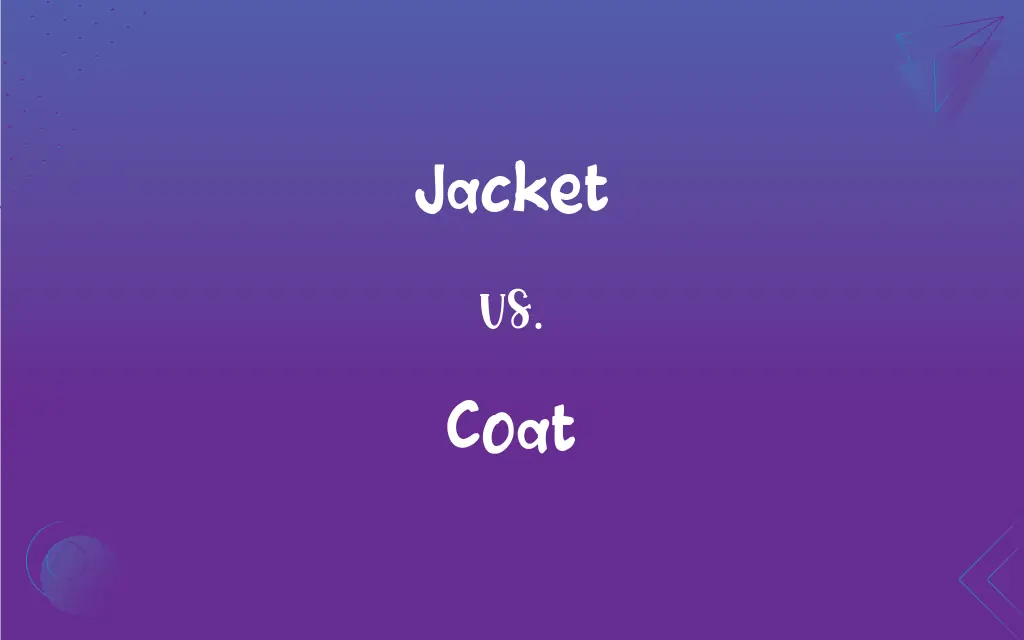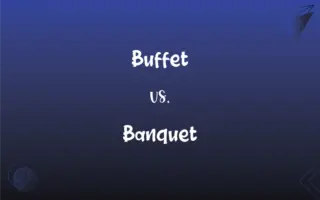Jacket vs. Coat: What's the Difference?
Edited by Aimie Carlson || By Harlon Moss || Updated on June 30, 2024
Jackets are typically lightweight, shorter, and more casual, while coats are longer, heavier, and offer more warmth, often being more formal.

Key Differences
Jackets and coats, both fundamental pieces of outerwear, offer variations in style and functionality that cater to diverse weather conditions and fashion preferences. Jackets, known for their lighter weight and shorter length, frequently serve to provide a modest layer of warmth and potentially a fashion statement. Conversely, coats traditionally extend below the hips and provide a denser shield against the elements, offering substantial insulation and protection during harsher weather.
Examining the aesthetic and stylistic variances, jackets often align with casual and sporty apparel, making them suitable for a relaxed outing or physical activities. Simultaneously, coats, with their elongated structure and often more meticulous tailoring, cater to a range of formal events, seamlessly complementing dressier attire, indicating a more sophisticated or polished look.
Material usage in jackets and coats also demonstrates a stark distinction in their primary functions. Jackets, utilized often in milder weather, might be constructed of lighter materials such as denim or light leather. On the flip side, coats are crafted with the intention of safeguarding the wearer from potentially severe conditions, employing heavier materials like wool or heavy-duty insulated fabrics.
The realm of jackets offers a versatile array, including bombers, blazers, and windbreakers, each with a distinct aesthetic and purpose, aligning with more laid-back and activity-oriented occasions. In contrast, coats, embodying forms like trench coats, pea coats, and overcoats, lend themselves to a spectrum from semi-formal to formal attire, offering a genteel demeanor while providing profound protection against the cold.
While jackets and coats undeniably hold their respective forte in fashion and utility, their selection predominantly hinges on the desired look and requisite functionality. Jackets, your companion for a breezy day or a casual meet-up, meld comfort with style. In comparison, coats stand as the bulwark against winter’s grasp, blending elegance with profound warmth, solidifying their stance as a winter wardrobe staple.
ADVERTISEMENT
Comparison Chart
Length
Typically shorter, ending at the hips
Generally longer, extending below the hips
Weight
Lighter and suitable for milder weather
Heavier and designed for colder weather
Formality
Often considered casual or semi-formal
Can range from casual to very formal
Materials
May use lighter materials like denim
Often crafted from heavier materials like wool
Styles
Includes bombers, blazers, windbreakers, etc
Encompasses overcoats, pea coats, trench coats, etc
ADVERTISEMENT
Jacket and Coat Definitions
Jacket
A metal casing used in certain types of ammunition.
The bullet had a full metal jacket.
Coat
The fur, wool, or hair covering of an animal.
The dog’s shiny coat shows it is in good health.
Jacket
An addition to a document, often for its protection or official identification.
Legal documents might be stored in a clear plastic jacket.
Coat
A layer covering something else; a covering or overlaying.
The painter applied a clear coat to protect the mural.
Jacket
An outer covering or casing used to protect or insulate materials.
The hot water tank had a thick jacket to prevent heat loss.
Coat
An outer garment worn on the upper body and varying in length and style according to fashion and use.
His woolen coat kept him warm throughout the winter.
Jacket
A garment for the upper body usually having a front opening, collar, lapels, sleeves, and pockets.
She wore a denim jacket over her dress.
Coat
A covering of material, such as paint or varnish, that provides a protective layer.
The wooden fence needed an extra coat of paint.
Jacket
A cover or structure around an object, designed for protection or support.
The ship's engine was covered with a protective jacket.
Coat
To cover with a layer or coating.
She decided to coat the cake with chocolate icing.
Jacket
A short coat usually extending to the hips.
Coat
A sleeved outer garment extending from the shoulders to the waist or below.
Coat
See suit coat.
FAQs
Are jackets typically longer or shorter than coats?
Jackets are typically shorter than coats.
What is the primary purpose of a jacket?
Jackets provide a light layer for warmth and are often used for fashion or casual wear.
Can a coat be used for formal occasions?
Yes, certain styles of coats, like overcoats, are suitable for formal occasions.
Which is typically heavier, a jacket or a coat?
Coats are generally heavier than jackets.
Is it common for jackets to be worn in the spring?
Yes, jackets are often worn in the spring due to their lighter weight.
Can a jacket be made of leather?
Yes, leather jackets are quite popular and come in various styles.
Can a coat have a belt?
Yes, some styles of coats, like trench coats, typically feature a belt.
Are coats only worn in winter?
While coats are commonly associated with winter, lighter coats can be worn in other seasons.
What's a bomber jacket?
A bomber jacket is a short, durable jacket with a zippered front and fitted or elastic waist and cuffs.
Can coats be sleeveless?
Yes, certain styles of coats, like vests, are designed to be sleeveless.
What materials are commonly used to make coats?
Coats can be made from various materials, including wool, cotton, polyester, and more.
Is a trench coat considered a coat?
Yes, a trench coat is a specific style of coat.
Do jackets always have zippers?
No, jackets can have zippers, buttons, toggles, or other types of fasteners.
Is it possible for a coat to be waterproof?
Yes, some coats are designed to be waterproof or water-resistant.
Are blazers considered jackets?
Yes, blazers are a type of jacket, often used for semi-formal occasions.
What distinguishes a jacket from a shirt?
Jackets are typically open-fronted and meant to be worn over other garments.
Is a parka considered a coat?
Yes, a parka is a type of heavy coat, often used in extremely cold weather.
Can I wear a coat during a rainy season?
Yes, certain coats are designed to provide protection during the rainy season, such as raincoats.
Are jackets more casual than coats?
Jackets are often considered more casual, but there are formal varieties as well.
Can a jacket be padded for extra warmth?
Yes, there are varieties of jackets that are padded or quilted for additional warmth.
About Author
Written by
Harlon MossHarlon is a seasoned quality moderator and accomplished content writer for Difference Wiki. An alumnus of the prestigious University of California, he earned his degree in Computer Science. Leveraging his academic background, Harlon brings a meticulous and informed perspective to his work, ensuring content accuracy and excellence.
Edited by
Aimie CarlsonAimie Carlson, holding a master's degree in English literature, is a fervent English language enthusiast. She lends her writing talents to Difference Wiki, a prominent website that specializes in comparisons, offering readers insightful analyses that both captivate and inform.































































